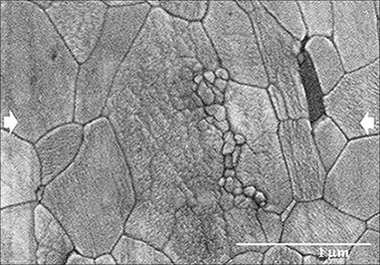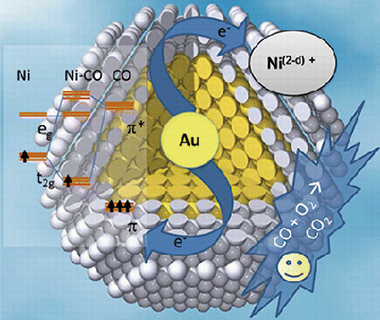Artículos SCI
2013
2013
Reactividad de Sólidos
Evidence of nanograin cluster coalescence in spark plasma sintered α-Al2O3
Morales-Rodriguez, A; Poyato, R; Gallardo-Lopez, A; Munoz, A; Dominguez-Rodriguez, AScripta Materialia, 69 (2013) 529-532
Show abstract ▽

The aim of this study is to elucidate the coarsening kinetics involved during densification of fine-grained pure α-alumina by spark plasma sintering. Low temperature and short dwell time sintering conditions were used to preserve the nanocrystalline structure of the starting commercial powder (about 50 nm). Notwithstanding the above, submicron grain coarsened microstructures have been developed. The microstructure evolution of alumina under different sintering conditions points to a nanograin rotation densification mechanism as being responsible for the fast grain growth observed.
Octubre, 2013 | DOI: 10.1016/j.scriptamat.2013.06.019
Química de Superficies y Catálisis
Gold(III) stabilized over ionic liquids grafted on MCM-41 for highly efficient three-component coupling reactions
Bobadilla, LF; Blasco, T; Odriozola, JAPhysical Chemistry Chemical Physics, 39 (2013) 16927-16934
Show abstract ▽

Two alkoxysilyl-modified ionic liquids (ILs) have been synthesized and further grafted onto mesoporous silica, MCM-41; these ionic liquids were used for dispersing AuCl3 catalysts that activate C–H bonds as required for the synthesis of propargylamines by coupling alkyne, aldehyde and amine (A3 coupling) species. 29Si NMR experiments demonstrate the formation of covalent bonds between alkoxysilyl-modified Bmim IL and the MCM-41 surface through silanol groups. The catalytic activities of Au(III)-supported MCM-41 and Au(III) homogeneous catalysts are lower than those obtained for the IL functionalized Au–MCM-41 solids when the same gold loading is considered. An interaction between Au(III) species and the IL is proposed for explaining the stabilization of gold(III) species. However, successive reaction cycles result in a decrease in the catalytic activity that has been explained on the basis of gold leaching.
Octubre, 2013 | DOI: 10.1039/C3CP52924J
Materiales y Procesos Catalíticos de Interés Ambiental y Energético
Promotional effect of the base metal on bimetallic Au-Ni/CeO2 catalysts prepared from core-shell nanoparticles
Holgado, JP; Ternero, F; Gonzalez-delaCruz, VM; Caballero, AACS Catalysis, 3 (2013) 2169-2180
Show abstract ▽

A set of three catalysts (a Au–Ni bimetallic and their corresponding Au and Ni monometallics) has been prepared by impregnation of previously prepared suspensions of monodisperse metallic particles to ensure the precise control of their physicochemical characteristics (size and composition). The Au–Ni/CeO2 bimetallic catalysts present better reactivity toward CO oxidation than monometallic Au/CeO2 and Ni/CeO2 prepared under identical conditions. “operando-like” characterization of Ni and Au atoms into the bimetallic particles using, among other techniques, ambient-pressure photoelectron spectroscopy and diffuse reflectance infrared Fourier transform spectroscopy has allowed us to determine that under oxidative conditions the samples present a Au@NiO core–shell distribution, where Ni surface atoms are affected by an electronic effect from inner Au atoms.
Septiembre, 2013 | DOI: 10.1021/cs400293b
Reactividad de Sólidos
The Ozawa’s generalized time concept and YZ-master plots as a convenient tool for kinetic analysis of complex processes
Malek, J; Koga, N; Perez-Maqueda, LA; Criado, JMJournal of Thermal Analysis and Calorimetry, 113 (2013) 1437-1446
Show abstract ▽
The concept of generalized time θ=∫exp(−Ea/RT)dt θ = ∫ exp ( − E a / RT ) d t in non-isothermal kinetics was introduced by Ozawa in 1965, together with the well-known isoconversional plot, i.e., Ozawa plot. The generalized time is the key concept to tie the kinetic data under varying temperature to the kinetic relationship at a constant temperature. It is well known that many processes studied by thermal analysis and calorimetry reveal a complex nature. Therefore, the generalized time concept seems to be very useful for the description of the change in the rate behavior depending on the fractional conversion. Using the concept of θ, three kinds of experimental master plots can be formalized in differential, integral, and multiplied forms. Among others, combination of the differential and multiplied master plots, y(α) = (dα/dθ) and z(α) = (dα/dθ)θ, show a high performance to discriminate the kinetic model based on the maxima condition of y(α y*) and z(α z*). The α y* − α y* kinetic plot is a useful tool to visualize the complexity of the kinetic process and to determine the most suitable kinetic model. The usefulness of α y* − α y* kinetic plot and the YZ-master plots is illustrated as exemplified by the kinetic analyses of complex crystallization processes of the as-prepared, thermally and mechanically treated amorphous zirconia.
Septiembre, 2013 | DOI: 10.1007/s10973-013-2939-0
Materiales Avanzados
Planning collection and solid waste flow (construction and demolition, concrete, ceramics and others) by utilizing a computerized tool for sustainable management
Garzon, E; Sanchez-Soto, PJBoletin de la Sociedad Española de Cerámica y Vidrio, 5 (2013) V-XIV (Notas Técnicas)
Show abstract ▽
Se presenta un procedimiento para la planificación de recogida y flujo de los residuos sólidos (de construcción y demolición, hormigón, cerámica, vidrio y otros) basado en la utilización de una herramienta informatizada, para conseguir una optimización de su gestión. Dicho procedimiento parte de normativa establecida según un Plan Director Territorial de la Gestión de Residuos Sólidos Urbanos (RSU) aprobado en una Comunidad Autónoma, en este caso se particulariza a la de Andalucía, tomando como ejemplo el volumen de residuos que se producen en una colectividad de tamaño medio (provincia de Almería), siendo extensible a otras mayores en población y territorio, disponiendo de datos actualizados.
El procedimiento utiliza una herramienta informática de gran difusión en el mundo, como es Google Earth y, de este modo, genera un número de “Centros deTransferencia” con objeto de minimizar el gasto de transporte, partiendo de una premisa previa en cuanto a distancia entre núcleos poblacionales y centros de tratamiento. Los Centros generados con la aplicación del procedimiento se pueden visualizar en un mapa topográfico, con áreas de influencia y vías de acceso a los mismos y se le pueden asociar una serie de datos tabulados con información adicional de utilidad. El procedimiento propuesto se va retroalimentando de manera constante con datos reales e información de campo, permitiendo a las empresas que producen residuos de distinta tipología como son los residuos de construcción y demolición principalmente, pero también hormigón, cerámica, vidrio, mezclas de todos ellos, residuos clasificados como peligrosos e incluso de otros materiales, a la propia administración y a la sociedad, en general, conocer las tasas de cada planta de tratamiento y qué se hace con los residuos entregados para contribuir a la reducción del impacto medioambiental de los mismos y a su gestión sostenible.
Septiembre, 2013 | DOI: 10.3989/cyv.2013.v52.i5
- ‹ anterior
- 294 of 421
- siguiente ›














